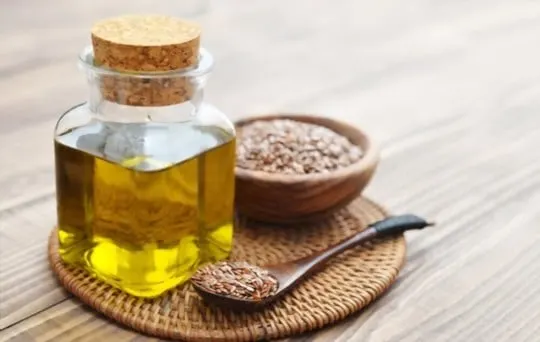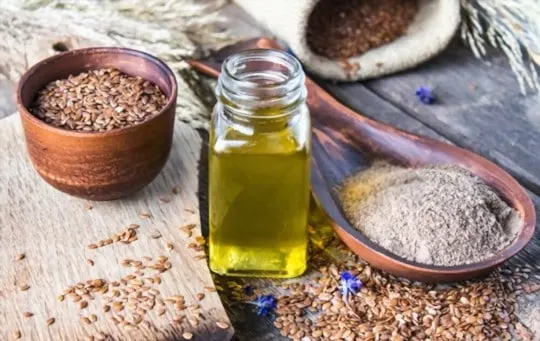If you’ve heard of flaxseed, you’re not far off from flaxseed oil.
In fact, it has become an extremely popular supplement within the food sector.
This brings us all to a simple question – what does flaxseed oil taste like? Does it carry any flavor, or does it have any actual benefit?
You’re in the right place if you’ve asked at least one of these questions.
Today’s article will dive into the world of flaxseed oil and have all your queries answered.
So, if this excites you, we suggest you sit tight until the end of the article to know all the deeds.
Let’s start.
What is Flaxseed Oil?

Flaxseed oil is a type of oil taken from the flaxseed plant, aka Linum usitatissimum.
The plant carries an essential omega-3 fatty acid called alpha-linolenic acid, which is considered a vital acid which our body can’t produce/create naturally.
Hence, we often seek the acid from different foods that we eat.
The oil is often taken as a supplement to maintain a sharp mind and healthy heart and look after our overall well-being.
Some people also use the oil for cooking.
However, it should be used cautiously while cooking as the oil can’t handle high heat.
Hence, it’s best not to follow high-heat cooking methods.
Flaxseed oil is typically available in two forms – a soft gel capsule or a liquid.
When handling the oil, storing it in a dark and cool place to prevent spoilage is essential.
Although flaxseed oil is a well-known supplement, it’s vital to talk to a medical professional if you plan on including it in your daily diet.
What Does Flaxseed Oil Taste Like?

Flaxseed oil comes with a distinct nutty flavor and hints of grassiness.
Some people compare its taste and flavor to nuts like hazelnuts or walnuts.
However, its actual taste can vary based on the oil’s quality and how it’s been processed.
The aroma of flaxseed oil is similar to its taste and flavor, meaning it has a slightly nutty aroma.
However, as mentioned earlier, even the scent can vary based on the oil’s overall quality.
But, generally, the smell isn’t as overpowering.
You may also get scent of earthy and grassy notes in flaxseed oil.
It’s also essential to be aware of the oil’s short longevity.
Flaxseed oil can get spoiled pretty fast if it’s not stored correctly.
You’ll be able to spot if the oil gets rancid, as it’ll most likely produce an unpleasant odor similar to a fishy or sour smell.
So, if you detect such an unpleasant, pungent smell, it’s best to throw the oil away.
Certain varieties of flaxseed oil may also vary in terms of bitterness and strength.
So, if it’s your first time trying the oil, it’s best to taste it before buying large quantities.
Flaxseed is also prized for its health benefits due to its high ALA content, which is a form of fatty acid.
This helps with improving heart health, reducing inflammation, and more.
However, it’s crucial to understand that flaxseed oil isn’t a complete source of omega fatty acids, so don’t entirely depend on the oil.
How to Use Flaxseed Oil?

Normally, cooking using flaxseed oil is not recommended due to its low smoke point and oxidation due to heat exposure.
However, just because it can’t be cooked doesn’t mean it can’t be eaten.
There are several ways you can serve flaxseed oil without doing any cooking.
Flaxseed oil is considered an incredibly versatile ingredient, and it can be served in the following ways:
- Salad dressing: You can use the oil as a salad dressing base, either mixed with other oils and ingredients or entirely on its own. .
- Smoothies: You can add flaxseed oil to smoothies once the smoothie is completely blended. This will help in preventing oxidation. .
- Drizzle on cooked veggies: You can drizzle a handsome amount of flaxseed oil on cooked veggies such as broccoli, cauliflower, and more. .
- Yogurt/oatmeal mixture: To enhance the nutritional value of your breakfast, you can simply drizzle some flaxseed oil on your oatmeal/yogurt bowl. .
These are only a few ways to utilize and serve flaxseed oil.
When you work with a versatile and healthy ingredient such as flaxseed oil, you can reap tons of health benefits while also incorporating them into various dishes.
So, make sure you’re also on the lookout for new recipes.
Conclusion
So, there you have it.
Our insightful guide on the taste of flaxseed oil, its uses, and what it exactly is.
We hope our article has provided valuable insights into this health supplement.
That said, taking proper precautions before incorporating this into your diet is crucial.
It’s also essential to look out for which cooking methods complement the oil best and avoid those that don’t.
Today, you can find flaxseed oil at your local supermarket, online stores, and more.
So, if you want to enhance your healthcare, you can try the oil.

What Does Flaxseed Oil Taste Like? Does it Taste Good?
Ingredients
- Flaxseed oil
- Ingredients from your favorite recipes
Instructions
- Depending on the ingredients used, the cooking method, and the type of dish, the taste of the food can vary greatly.
- Make sure to select a recipe that will elevate the food’s original flavor, and enjoy experimenting with different recipes!

Andrew Gray is a seasoned food writer and blogger with a wealth of experience in the restaurant and catering industries. With a passion for all things delicious, Andrew has honed his culinary expertise through his work as a personal chef and caterer.
His love for food led him to venture into food writing, where he has contributed to various online publications, sharing his knowledge and insights on the culinary world. As the proud owner of AmericasRestaurant.com, Andrew covers a wide range of topics, including recipes, restaurant reviews, product recommendations, and culinary tips.
Through his website, he aims to inspire and educate fellow food enthusiasts, offering a comprehensive resource for all things food-related.

Leave a comment